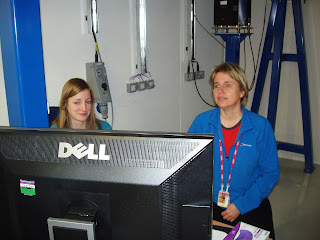Just back from a really great site visit to the Sandford Farm Remediation site near Woodley, Reading.
The site was a landfill tip from the 1960s to 1990s and has since been disused. At the end of its life the tip was capped with clay and top soil it was just left as scrub.
 |
| This gives a view of what the site was like before development started |
The site is now being developed for housing. There are two issues for consideration - gas emissions from biodegradation going on in the land fill and subsidence as the material in the landfill degrades and compacts. Neither is good for housing so the site has to be made safe.
The first thing that is done is the top soil is removed and stored - it is used to form a raised mound around the site, shielding near by residents from the noise and view of the site. The clay cap is also removed and stored for re-use.
 |
Top soil removal
The soil stays on site and is used to create barriers to reduce sound and visual pollution from the site. |
 |
| Once the top soil has been removed you are left with the clay cap that is also removed |
Next the rubbish has to be excavated from the landfill for removal of biodegradable material that could result in gas emissions.
Material that is relative fine grained, or is predominantly soil can be hand sorted on a conveyor belt.
The rest of the material is dumped for processing, really coarse material is separated into wood (for re-use off site), rubble (for re-use as fill on site) and plastics / tyres (for disposal off site).
Otherwise the material is sorted with machinery, initially removing coarse material.
Air blades blow off the low density plastics into a cage for collection and off site disposal.
The remaining material is put through a soil washing plant.
This works just like a gravel quarry and produces materials of different grades.
The really fine material is dewatered using a filter press.
The water is treated at an on site water treatment site and then reused.
The various stock piles of material are reblended to an engineering grade material and the excavated landfill refilled. It has had the biodegradable material (wood) removed so there is no longer a gas hazard and the refill is designed to an engineering specification so there is no subsidence risk.
Levelling off a refilled landfill site.
At the end of the process the site is all ready for building houses. The majority of the old landfilled material has been reused as engineered back fill and the plastic waste that can't be used occupies far less space than before. And no green belt land has been used to produce some urgently needed new family homes. All excellent stuff.














































.JPG)


